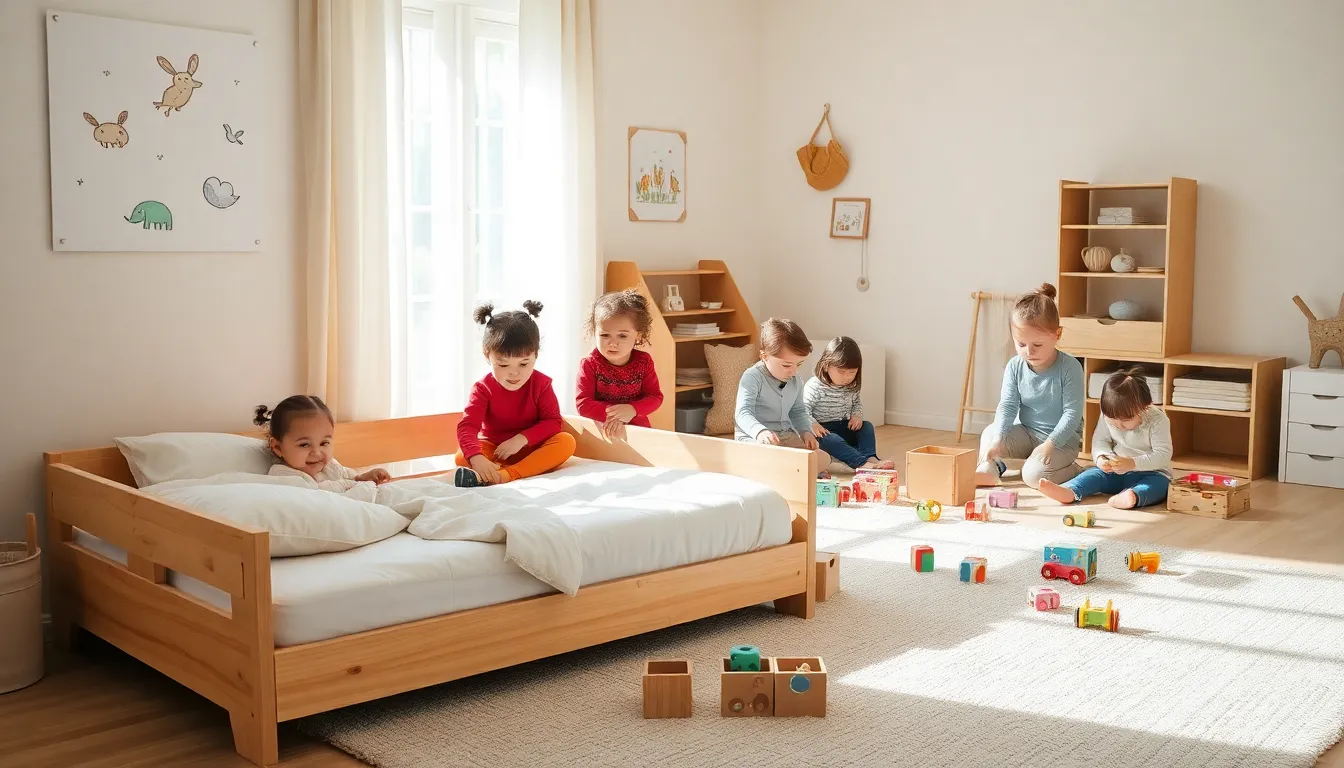Ever heard of toddlers testing their limits? They’re true little explorers who often prefer being their own masters. Enter the Montessori toddler floor bed. Imagine a bed that not only encourages independence but promotes a peaceful night’s sleep. Sounds idyllic, right? In this text, we jump into the intriguing realm of Montessori floor beds, unraveling their secrets and benefits while ensuring you don’t sleep through the essentials. Get ready to discover how this simple change can vastly improve bedtime routines.
Table of Contents
ToggleUnderstanding the Montessori Method

The Montessori method is all about fostering a child’s natural development through a rich, nurturing environment. Dr. Maria Montessori believed in giving children the freedom to learn at their own pace. This educational philosophy centers around creating opportunities for exploration and independence. When it comes to sleep, this translates into a space where toddlers can feel secure and autonomous. A Montessori floor bed embodies this principle perfectly. It invites children to choose when to sleep and when to wake, reinforcing their confidence and curiosity.
This method lays the groundwork for a child’s healthy emotional and physical development. From understanding their needs to respecting their choices, the Montessori approach empowers children to thrive in an engaging environment.
Benefits of a Floor Bed for Toddlers
Who wouldn’t want a better sleep solution for their little ones? A floor bed offers a treasure trove of benefits. First and foremost, it allows toddlers easy access to their sleeping space. Gone are the days of feeling trapped in a crib. They can hop in and out, exploring their environment at their own pace.
Also, floor beds encourage a sense of independence. When toddlers can decide their bedtime, they often feel more in control, which can lead to a positive attitude towards sleep. Besides, a floor bed can be tremendously comforting. With a soft, cozy bed close to the ground, children are less likely to fear falling. After all, kids can be champion cliff divers, into nothing but thin air.
Choosing the Right Floor Bed
Selecting a floor bed might feel overwhelming, particularly with the range of styles, materials, and designs on the market. Fear not. The ideal floor bed should prioritize safety, comfort, and aesthetics. Look for options made from non-toxic materials to ensure a healthy sleeping environment, especially considering those teething days. A minimalist design typically resonates well with the Montessori aesthetic, blending seamlessly with your home décor.
Size matters too.
Ensure the bed fits well in your child’s space, allowing for some room to play. A low-profile frame is ideal, giving your toddler the security they need while boosting accessibility. It can be tempting to jump into trendy themes, but a bed that allows flexibility for them to grow is a wise choice.
Setting Up a Montessori Floor Bed
Setting up a Montessori floor bed is as easy as pie, just minus the whipped cream. Start by selecting a quiet area of the room, away from distractions. Next, arrange the bed with soft bedding and cozy blankets to create an inviting retreat. This soft nest should feel warm and welcoming, making it a haven your toddler can’t wait to snuggle into.
Consider adding some personal touches, such as their favorite pillows or stuffed animals, to further enhance the cozy atmosphere. Making the bed accessible is paramount: if you can integrate it into their play space, all the better. A thoughtfully designed area promotes exploration and independence.
Safety Considerations
Safety should always be a priority when it comes to your little one’s sleeping arrangements. With floor beds, parents should mitigate risks while maximizing comfort. First and foremost, ensure the area around the bed is clear of sharp objects or hard furniture to prevent any accidents. Utilizing a mattress that’s firm, yet comfortable, minimizes the risk of suffocation or entrapment too.
Also, avoid placing the bed close to windows or heavy furniture to prevent potential tumbles. It’s also wise to check in on your toddler frequently, especially during their early days of transitioning to a floor bed. Familiarization with their new space is essential, as they learn to navigate the freedom it offers.
Transitioning to a Floor Bed
Transitioning your toddler to a floor bed can feel like a daunting leap: but, it can also be an exciting adventure. Start by introducing the bed gradually. Consider letting them explore it during playtime. This reassures them that it’s a safe and enjoyable space. You might even encourage them to help with the bed’s setup, allowing them to develop a sense of ownership.
Initially, maintain the familiar bedtime routine to help ease any anxiety. Sing their favorite lullabies, dim the lights, and read bedtime stories, as comforting rituals remain crucial in helping your toddler adjust to this new environment. Give it some time, as navigating change often requires patience and understanding.


